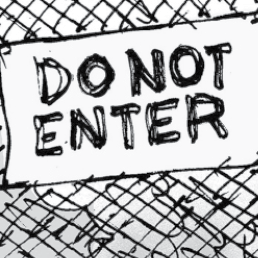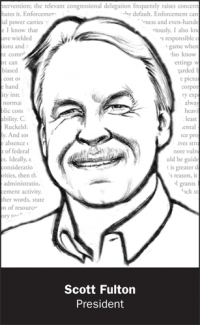When the System Fosters Racial Injustice

By the time the environmental justice movement began taking shape in the 1980s, communities of color had already been suffering from the disproportionate burdens of pollution for decades. Since then, evidence of racially discriminatory patterns in the distribution of environmental harms has only continued to mount.
Researchers from the universities of Michigan and Montana empirically documented in a pair of 2015 studies the phenomenon of “sacrifice zones,” finding that industrial facilities associated with high levels of pollution are disproportionately sited in low-income communities and communities of color. A 2019 study published in the Proceedings of the National Academies of Science found that while White people in the United States are disproportionately responsible for particulate matter pollution — which is linked to heart disease, permanent lung damage, and premature death — Black people and Latinos endure significantly greater exposure to this pollution.
But even as environmental justice has grown in prominence, early policy responses in its support have been lackluster, undermined by tepid commitment from political leaders, inadequate resources, and feeble accountability measures. Executive Order 12898, which was first issued in 1994, directs that “each federal agency shall make achieving environmental justice part of its mission,” but compliance has largely remained an afterthought. In 2018, a federal court held EPA in violation of Title VI of the 1964 Civil Rights Act for persistently failing to address communities’ environmental justice complaints for more than a decade. In 2019, the Government Accountability Office found a systematic failure by key federal agencies to fulfill their responsibilities under the directive. So it is unsurprising that among President Biden’s first acts in office was an executive order that includes some promising updates and reforms to EO 12898. An early mark of his administration will be how well those reforms are implemented on the ground.
The unjust events of the past year may bring long overdue change. In the wake of George Floyd’s violent alleged killing at the hands of a Minneapolis police officer and the waves of protests it spurred in cities across the country, many White Americans are now grappling with the racial demons that haunt our nation. Many who have never been the victims of racial discrimination are now starting to recognize the patterns of disparate impacts that can result from our existing institutions and other underlying structural forces. These results can occur even if those institutions and structures were not designed with racially discriminatory intent. It’s time for policymakers, advocates, and the legal profession to act.
Several systemic causes contribute to race-based disparities in environmental and public health harms. One of these causes results from the role of the regulatory system in implementing and enforcing environmental policies. Even though absent of racist intent, certain institutions and procedures within the regulatory system produce discriminatory effects. This article focuses on three such features: cost-benefit analysis; the erosion of the precautionary principle; and “information injustice,” which I’ll define later. Ultimately, advancing environmental justice requires equity-informed reforms to relevant institutions and procedures.
When it comes to institutional procedures that reinforce and perpetuate racial disparities in environmental harms, few are more influential than cost-benefit analysis. Its prominence has grown steadily over the past forty years. A series of executive orders dating back to the beginning of the Reagan administration has charged agencies with performing cost-benefit analyses on their most significant rules when submitting them for review to the White House Office of Information and Regulatory Affairs. These analyses are intended to inform agencies of the likely impacts of pending regulations and, where legal, improve the substantive “quality” of agency decisionmaking.
Cost-benefit analysis comes in many varieties: the predominant version is grounded in welfare economics theory. This version sees our nation’s aggregate wealth maximization as its ultimate goal and thus endeavors to steer regulatory decisionmaking accordingly. In practice, it tends to be hyper-technical and formalistic. This is due to its aspirations of acquiring comprehensive knowledge about a potentially infinite number of possible regulatory approaches, so as to identify the “economically optimal” one — that is, the approach that maximizes net benefits by balancing a regulation’s costs and benefits at the margin. The requirements of Executive Order 12866, which currently governs cost-benefit analysis, largely follow this approach.
The virtue of this formalistic version of cost-benefit analysis, according to its defenders, is that it promotes rational decisionmaking by insulating it from the messiness of resolving incommensurable subjective values, such as fairness and equity. But it is precisely this commitment to supposed “moral objectivity” that has left the practice vulnerable to producing racially disparate results.
This dynamic first comes into play at the very beginning of the cost-benefit process, when the analytical baseline is defined for the purposes of comparing potential policy impacts. The problem arises when the status quo conditions that make up that baseline include aspects of racial injustice and inequality. Once racism is baked into the baseline, the analytical results may become distorted in ways that reinforce preexisting race-based inequities, which can be significant in the context of environmental policymaking.
For example, decades of discriminatory land-use policies have given rise to sacrifice zones in neighborhoods near polluting industrial facilities. In these areas, people of color and low-income communities are heavily concentrated. In the standard assessment of a regulation to control toxic air pollution from such facilities, these injustices would be included as merely another part of the analytical baseline. To the extent that the analysis would then focus on incremental pollution increases beyond this baseline, it would fail to properly account for the cumulative burdens these frontline communities already suffer, thereby making it harder to justify sufficiently protective regulations.
Once the baseline is defined, the next step is to evaluate the rule’s potential impacts. Here, too, the misguided desire for objectivity can embed racial injustice in the results. Formalistic cost-benefit analysis gives rise to this problem by automatically assigning equal moral weight to the competing interests affected by a given regulation. In environmental policymaking, this happens when cost-benefit analysis treats the expenses that a corporation would incur through compliance costs as ethically commensurate with the compromised health, diminished quality of life, and premature deaths experienced by affected communities. This can produce racially discriminatory impacts when the analysis holds that a particular air pollution regulation must be rejected or weakened because the amount of money it would force a company to spend to clean up its pollution exceeds the monetary value of preventing people of color in fenceline communities from getting sick.
Similarly, the practice of monetization intrinsic to formalistic cost-benefit analysis provides another avenue for distorting regulatory decisionmaking in ways that reinforce racial injustice. To compare costs and benefits, economists conducting analyses try to convert public health, a pollution-free environment, and other nonmonetary values and benefits into dollar figures so they can be directly compared with and balanced against the costs of a regulation, which are more naturally expressed in monetary terms.
Several techniques that analysts employ to place a monetary value on nonmarket goods protected by environmental regulations can unintentionally introduce racial bias. An example is ascribing a monetary value to preventing premature deaths. The most common technique economists use is to generate a value of a statistical life derived from observed wage premiums for work that involves a slightly higher risk of death. Significantly, research from Vanderbilt University economist Kip Viscusi shows that Black workers tend to receive smaller wage premiums than White workers, which implies that preventing premature deaths among African Americans is worth less. Of course, Black workers don’t “value” their lives less than White workers, but structural racism in the labor market has left them with weaker bargaining power to demand higher wages.
While some have called to adjust the value of a statistical life to account for race in cost-benefit analyses, fortunately these calls have not yet been heeded, since they would lead to weaker protections in regulations that primarily benefit people of color. This example illustrates how monetization techniques can promote racially discriminatory results.
If formalistic cost-benefit analysis represents an approach to environmental policymaking that is excessively biased against strong regulations, then the precautionary principle repre-
sents its polar opposite. This principle is expressly biased in favor of strong regulation. Legal scholars such as David Driesen have sought to reconcile the theoretical underpinnings of these philosophies, but in practice they appear to be mutually exclusive. Indeed, the rise of formalistic cost-benefit analysis has, as if by hydraulic force, displaced the precautionary principle’s influence in regulatory decisionmaking.
As with cost-benefit analysis, the precautionary principle is not a monolithic concept but rather encapsulates a range of variations. For simplicity’s sake, legal scholars distinguish between weak and strong versions. Broadly speaking, the weak version holds that lack of evidence alone is not sufficient grounds for failing to take protective action to prevent serious harm to health or the environment. In other words, this version dictates how precaution should bear on the threshold decision of whether to take regulatory action in the face of uncertainty. In contrast, the strong version generally calls for some form of robust regulatory action, even if costly, whenever a significant threat to health or the environment emerges. This version thus focuses more on what kind of regulatory action to take; what makes it strong is its default to robust responses against threats that are significant enough even if we lack complete certainty.
The weak version has long been recognized as an animating principle of modern U.S. environmental law. Landmark court decisions such as Reserve Mining Co. v. EPA in 1975 and Ethyl Corp. v. EPA in 1976 held that neither the Clean Water Act nor the Clean Air Act requires conclusive proof that a particular polluting activity significantly harms public health before EPA can take regulatory action to limit that activity.
Both versions of the precautionary principle have been enshrined in various provisions across our major environmental statutes. The Clean Air Act embraces the weak version when it authorizes the agency to limit hazardous air pollutants from fossil-fueled power plants if it finds that such regulations would be “appropriate and necessary” based on a “study of the hazards to public health reasonably anticipated to occur as a result of” those pollutants. The strong version is consistent with various technology-based standards common to U.S. environmental law. The trigger for applying these standards does not require certainty about the environmental or public health risks to be addressed, and the default regulatory response, while sensitive to cost considerations, is not strictly dictated by them.
Perhaps the clearest statement of the strong version is the Clean Air Act’s call for EPA to set National Ambient Air Quality Standards at a level “allowing for an adequate margin of safety.” As Justice Antonin Scalia explained in Whitman v. American Trucking, the act directs EPA to account for this margin by first determining “the maximum airborne concentration of a pollutant that the public health can tolerate” based on its research on the pollutant’s health effects, then “decreas[ing] the concentration” below that level. As important, he further concluded that “nowhere are the costs of achieving such a standard made part of that initial calculation.”
Despite this sure legal footing, the precautionary principle’s influence on environmental regulation has withered considerably in recent decades, and especially during the Trump administration. This is true even of the weak version, which is generally viewed as noncontroversial.
During the Obama administration, EPA’s rigid adherence to formalistic cost-benefit analysis at times trumped application of the precautionary principle. For example, in determining the “best technology available” for preventing harm to aquatic species caused by the cooling water intake structures at power plants, the agency rejected the more protective option of closed-cycle cooling technology in favor of a weak facility-based permitting program. The driving factor for this determination was a highly flawed cost-benefit analysis that failed to account for the vast majority of the rule’s potential benefits because the agency’s economists could not put a dollar figure on them. Minimizing costs on industry took priority over the intrinsic precautionary nature of the Clean Water Act.
The Trump EPA was much more aggressive in rejecting the precautionary principle. One of the first formal actions Trump’s first EPA administrator, Scott Pruitt, took was to reject a proposed ban on the neurotoxic pesticide chlorpyrifos under the Federal Insecticide, Fungicide, and Rodenticide Act. Chlorpyrifos is suspected of causing brain damage in children and other harms. But Pruitt claimed that “despite several years of study, the science addressing neurodevelopmental effects remains unresolved and . . . further evaluation of the science . . . is warranted.”
Trump’s second EPA administrator, Andrew Wheeler, rejected the advice of career scientists to strengthen the NAAQS for particulate matter, citing “important uncertainties in the evidence for adverse health effects below the current standards and in the potential for additional public health improvements from reducing ambient [particulate matter] concentrations below those standards.” It is hard to reconcile that conclusion with the weak form of the precautionary principle, let alone the Clean Air Act’s requirement that EPA build in an “adequate margin of safety” when setting NAAQS.
In short, the precautionary principle is gradually being hollowed out by an ever-increasing demand for certainty before regulatory action can be taken to address environmental and public health threats; when action is taken, that same uncertainty is used to block all but the most modest of protections. This trend is at odds with the principle, which aims to shift the costs of uncertainty to those who desire to undertake actions that present a risk of harm. Basic fairness considerations dictate that these parties bear the costs because they ultimately profit from the actions and because the information advantages they enjoy regarding their actions better position them to resolve the uncertainties of potential harms. Indeed, this cost-shifting scheme can be seen as a variation on the “polluter pays” principle in American environmental law, which holds that the party that causes pollution (i.e., through its profit-making activities) should shoulder the cost of remedying any resulting damage to the environment.
As the precautionary principle continues to decay, the practical upshot is that the costs of uncertainty are shifting to victims of pollution. Risks these individuals face — to their health, well-being, and property — increasingly go unaddressed because EPA must dedicate more time and resources to gathering evidence to support regulatory action to address them. In perhaps its grimmest form, these evidence-gathering activities include “counting the bodies” of victims of premature death from particular environmental or public health threats. Due to structural causes of inequity, these bodies are — or will be — disproportionately Black or Brown.
All too often, racial injustice emerges as a natural consequence from such rejections of precautionary approaches to environmental regulation, as the examples from the Trump administration discussed above illustrate. Farm workers most at risk of harmful exposures to chlorpyrifos are overwhelmingly Latinos. Similarly, research demonstrates that people of color are exposed to particulate matter at far greater levels than White people.
The agency is more likely to regulate environmental and public health risks it is aware of than those it isn’t. As Mustafa Santiago Ali, the former top environmental justice official at EPA, has noted, “Data drives policy, and the lack of data drives policy.” This dichotomy makes the issue of how information is gathered and used in the rulemaking process vitally important. The erosion of the precautionary principle, in which uncertainty can be weaponized to torpedo regulatory actions, only amplifies the stakes in these fights.
Uncertainty is an inescapable feature of environmental regulation, and its management is one of its central challenges. If the precautionary principle is ultimately about how to fairly allocate the costs of uncertainty through regulatory decisionmaking, then a related question involves how to fairly allocate the benefits of reducing uncertainty regarding environmental and public health risks. For the purposes of this article, I refer to this distributional concern as one of information injustice.
The general tendency of the environmental regulatory apparatus has been to “choose ignorance” (to borrow a phrase from University of Texas Professor Wendy Wagner) when it comes to harms that disproportionately affect historically marginalized communities. In contrast, environmental regulators are likely to place greater emphasis on understanding harms that affect elites. Because they reflect and reinforce broader power disparities in our society, these patterns of information injustice tend to produce racially inequitable results.
Once set, the pattern of information injustice self-perpetuates. That’s because regulation begets new information, which is then used to support additional regulation. The classic example is when EPA used the precautionary principle as a foothold to begin regulating the use of lead in gasoline despite uncertainty about the degree of harm it posed. Thanks to that initial regulation, the agency learned a great deal about the link between leaded gas and public health harms through subsequent epidemiological research, which later supplied the evidence for a full ban. The far more typical case, however, is characterized by a catch-22 that preserves the status quo: without regulation, a particular environmental risk is unlikely to be researched, but without research, an environmental risk is unlikely to be regulated in the first place.
Several norms and institutions within environmental law promote information injustice and contribute to its influence throughout the regulation development process. Common features like reliance on self-monitoring regimes for tracking emissions and strong confidential business information protections for regulated entities can undermine EPA’s efforts to gather essential exposure data for pollutants and toxic chemicals. A similar result arises from the agency’s use of census data to identify populations potentially exposed to certain pollutants or hazards to inform its regulatory decisionmaking. Such data can lead EPA to underestimate exposures for marginalized populations, especially people of color and individuals with insecure immigration status, since the census tends to systematically under count these populations.
A recent Associated Press investigation found that a combination of inadequate resources and poor implementation has contributed to huge gaps in air pollution monitoring systems overseen by EPA. According to the investigation, monitors routinely failed to capture even large pollution events such as major refinery explosions. These events likely resulted in acute exposures in neighboring fenceline communities in which historically marginalized populations disproportionately reside.
Information injustice’s pathologies likewise extend to EPA’s ability to study the dose-response relationships of many chemicals and pollutants that are essential for establishing adequate regulatory protections. For instance, the original Toxic Substances Control Act essentially conceded defeat on understanding the human health consequences of most of the existing chemicals in use at the time the law was enacted. The law grandfathered them into its regulatory program by allowing their continued sale without any up-front testing. The old TSCA’s approach to new chemicals was not much better, establishing only minimal testing requirements and providing the agency with little authority to demand additional information about chemicals’ potential harms. The 2016 updates to TSCA aim to rectify these errors, but the damage is already done: few of the more than 86,000 chemicals currently available for production have been subjected to any toxicity testing.
A similar dearth of dose-response information is evident in EPA’s pollution control regulations. For instance, the agency lacks such information for dozens of the toxic air pollutants it is supposed to control through the strict National Emission Standards for Hazardous Air Pollutants program. What little toxicity information it does have on those air pollutants is often decades old. The agency’s cost-benefit analyses further confirm its persistent failures in acquiring reliable dose-response information to support its pollution regulations. A recent empirical study of 45 analyses EPA conducted for major rules between 2002 and 2015 found that 80 percent excluded entire categories of benefits that the agency itself described as “important,” “significant,” or “substantial.” It excluded them because benefits were not quantifiable due to data limitations, including those characterizing dose-response relationships.
Finally, on those rare occasions when information does exist regarding particular environmental and public health hazards, significant obstacles remain before it can actually be used by EPA to inform its regulatory decisionmaking. Most notably, stakeholders opposed to stringent environmental regulations — including regulated industries and political conservatives — have created several institutional mechanisms within the rulemaking process for manufacturing doubt about the accuracy or quality of this information. The ultimate aim is persuading EPA to disregard it altogether. The 2001 Data Quality Act establishes a process for industry and special interest groups to challenge information that agencies use to support their regulations.
Another more recent example is the Trump EPA’s rule on Strengthening Transparency in Pivotal Science Underlying Significant Regulatory Actions and Influential Scientific Information, which required the agency to give less weight to dose-response studies for which all of the underlying data are not publicly available. (A federal district court has since struck down the rule.) The practical and intended effect of this rule was to subordinate the use of epidemiological public health research, such as the landmark Harvard Six Cities Study. By demonstrating the relationship between elevated levels of particulates and the increased incidence of premature deaths in affected populations, this study and subsequent research provides the scientific foundation for strengthened particulate matter NAAQS and other air pollution regulations opposed by powerful industry interests. Performing these studies, however, entails departing from standard transparency practices in science, since the patient data that researchers gather are governed by strict privacy agreements.
It is important to understand how these three features of the regulatory system can contribute to racially inequitable results in environmental policymaking so that we can take the next step of designing a reform agenda. One critical element will be recalibrating the relative influence of cost-benefit analysis and the precautionary principle such that the latter predominates. On his first day in office, President Biden issued a memorandum on “Modernizing Regulatory Review” that offers one possible vehicle for pursuing this reform. Congress, too, can contribute, either through surgical amendments to the Administrative Procedure Act or through standalone legislation. To address the problem of information injustice, policymakers should explore options for encouraging research targeted at understanding pollutants and toxic chemicals that disproportionately impact historically marginalized communities. These options should include rescinding unnecessary obstacles to the use of that information.
No doubt there are other structural features of the rulemaking system that contribute to racially inequitable results in environmental policymaking beyond the three discussed here. Work must continue to identify them as part of a broader process of rebuilding the regulatory system so that it affirmatively promotes racial justice. TEF
COVER STORY 1 Several causes contribute to race-based disparities in environmental and public health harms. One of these is the role of the regulatory system in implementing and enforcing environmental policies with discriminatory effects.





 ELI serves as the Secretariat for the International Network for Environmental Compliance and Enforcement (INECE). Founded in 1989, INECE is the only global organization focused exclusively on achieving compliance with environmental law through effective compliance promotion and enforcement strategies, including administrative, civil, criminal, and judicial enforcement.
ELI serves as the Secretariat for the International Network for Environmental Compliance and Enforcement (INECE). Founded in 1989, INECE is the only global organization focused exclusively on achieving compliance with environmental law through effective compliance promotion and enforcement strategies, including administrative, civil, criminal, and judicial enforcement.
 Cheryl E. Wasserman founded the Environmental Governance Institute International following 43 years in senior positions in EPA’s policy and enforcement offices. She led the Steering Committee and developed the Policy Framework on the State-Federal Enforcement Relationship 1984-94 and co-founded the International Network for Environmental Compliance and Enforcement.
Cheryl E. Wasserman founded the Environmental Governance Institute International following 43 years in senior positions in EPA’s policy and enforcement offices. She led the Steering Committee and developed the Policy Framework on the State-Federal Enforcement Relationship 1984-94 and co-founded the International Network for Environmental Compliance and Enforcement.